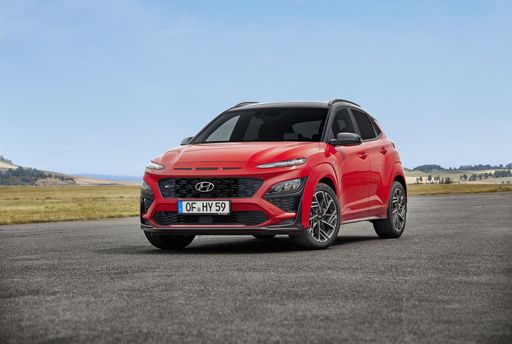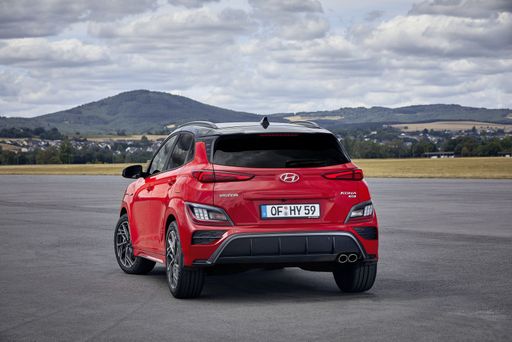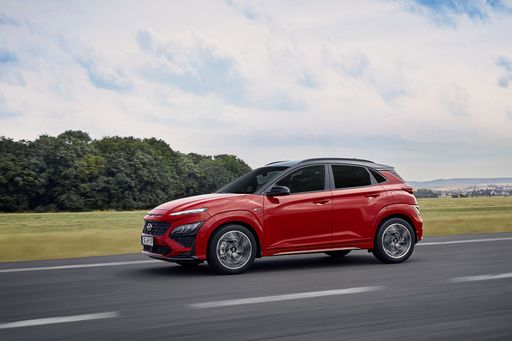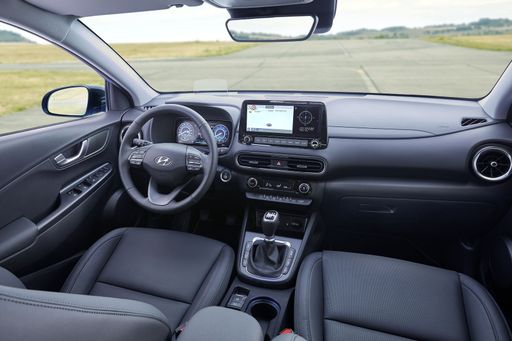Hyundai Kona VS Tesla Roadster – Specs, Efficiency & Price Comparison
Which model is the better choice – the Hyundai Kona or the Tesla Roadster? We compare performance (218 HP vs ), boot capacity (466 L vs 0 L), efficiency (14.60 kWh4.50 L vs ), and of course, the price (22600 £ vs 184300 £).
Find out now which car fits your needs better!
The Hyundai Kona (SUV) is powered by a Petrol, Full Hybrid or Electric engine and comes with a Manuel or Automatic transmission. In comparison, the Tesla Roadster (Roadster) features a Electric engine and a Automatic gearbox.
When it comes to boot capacity, the Hyundai Kona offers 466 L, while the Tesla Roadster provides 0 L – depending on what matters most to you. If you’re looking for more power, you’ll need to decide whether the 218 HP of the Hyundai Kona or the of the Tesla Roadster suits your needs better.
There are also differences in efficiency: 14.60 kWh4.50 L vs . In terms of price, the Hyundai Kona starts at 22600 £, while the Tesla Roadster is available from 184300 £.
Compare all the key specs now and find out which model fits your lifestyle best!
Hyundai Kona
The Hyundai Kona blends a bold design with a versatile interior, making it a standout choice in the compact SUV market. Its crisp handling and responsive steering provide an engaging driving experience, whether in the city or on the open road. The vehicle also offers a range of features designed to enhance comfort and connectivity, ensuring a pleasurable journey for both driver and passengers.
details @ hyundai.news
@ hyundai.news
 @ hyundai.news
@ hyundai.news
 @ hyundai.news
@ hyundai.news
 @ hyundai.news
@ hyundai.news
Tesla Roadster
The Roadster is a stunning embodiment of open-air driving, blending sleek design with exhilarating performance. With its sporty silhouette and agile handling, it offers an unmatched sense of freedom on the road. Enthusiasts revel in the combination of luxury and raw power, making every journey a memorable adventure.
details

|
|
|
|
|
Costs and Consumption |
|
|---|---|
|
Price
22600 - 41600 £
|
Price
184300 £
|
|
Consumption L/100km
4.5 - 6.7 L
|
Consumption L/100km
-
|
|
Consumption kWh/100km
14.6 - 16.8 kWh
|
Consumption kWh/100km
-
|
|
Electric Range
377 - 514 km
|
Electric Range
1000 km
|
|
Battery Capacity
1.3 - 65.4 kWh
|
Battery Capacity
-
|
|
co2
0 - 152 g/km
|
co2
0 g/km
|
|
Fuel tank capacity
38 - 47 L
|
Fuel tank capacity
-
|
Dimensions and Body |
|
|---|---|
|
Body Type
SUV
|
Body Type
Roadster
|
|
Seats
5
|
Seats
4
|
|
Doors
5
|
Doors
2
|
|
Curb weight
1370 - 1773 kg
|
Curb weight
-
|
|
Trunk capacity
466 L
|
Trunk capacity
0 L
|
|
Length
4350 - 4385 mm
|
Length
-
|
|
Width
1825 mm
|
Width
-
|
|
Height
1580 - 1585 mm
|
Height
-
|
|
Payload
420 - 490 kg
|
Payload
-
|
Engine and Performance |
|
|---|---|
|
Engine Type
Petrol, Full Hybrid, Electric
|
Engine Type
Electric
|
|
Transmission
Manuel, Automatic
|
Transmission
Automatic
|
|
Transmission Detail
Manual Gearbox, Dual-Clutch Automatic, Reduction Gearbox
|
Transmission Detail
-
|
|
Drive Type
Front-Wheel Drive, All-Wheel Drive
|
Drive Type
All-Wheel Drive
|
|
Power HP
100 - 218 HP
|
Power HP
-
|
|
Acceleration 0-100km/h
7.8 - 13.3 s
|
Acceleration 0-100km/h
2.10 s
|
|
Max Speed
162 - 208 km/h
|
Max Speed
402 km/h
|
|
Torque
200 - 265 Nm
|
Torque
10000 Nm
|
|
Number of Cylinders
3 - 4
|
Number of Cylinders
-
|
|
Power kW
74 - 160 kW
|
Power kW
-
|
|
Engine capacity
998 - 1598 cm3
|
Engine capacity
-
|
General |
|
|---|---|
|
Model Year
2024
|
Model Year
2025
|
|
CO2 Efficiency Class
D, C, E, A
|
CO2 Efficiency Class
A
|
|
Brand
Hyundai
|
Brand
Tesla
|
Hyundai Kona
The Hyundai Kona: A Comprehensive Overview
The Hyundai Kona has established itself as a standout in the compact SUV segment, blending innovation with performance and style. As the automotive world moves towards more sustainable and efficient options, the Kona offers a variety of powertrains, from traditional petrol engines to full hybrids and all-electric models.
Powertrain Options and Performance
The Hyundai Kona's powertrain choices cater to a wide range of preferences. For petrol enthusiasts, the Kona offers a 1.0L T-GDI engine, delivering 100 PS, and a more robust 1.6L T-GDI variant with up to 170 PS. Those looking for efficiency without sacrificing power can consider the full hybrid model, offering 129 PS and an impressive consumption of 4.5 L/100km.
For a greener option, the all-electric Kona provides a compelling case. With battery capacities of up to 65.4 kWh, the electric Kona offers power outputs of 156 to 218 PS, and efficiencies as low as 14.6 kWh/100km, enabling an electric range of up to 513 km.
Technical Specifications and Innovations
Built on a robust platform, the Kona delivers versatility and reliability. With a choice between manual or dual-clutch automatic gearboxes, along with options for front-wheel or all-wheel drive, the Kona ensures a tailored driving experience. The handling is enhanced by the car's lightweight construction, balancing a 1370 to 1773 kg curb weight with dynamic performance.
The Kona's design doesn't compromise cargo space for style; it offers a generous 466 L boot capacity. With a relatively compact body, measuring 4350 to 4385 mm in length, the Kona easily navigates urban environments while still commanding a strong road presence with its 1825 mm width.
Efficiency and Eco-Friendliness
Hyundai is committed to reducing emissions, as evidenced by the Kona's CO2 efficiency ratings, which range from class A for electric models to class D for some higher-performance petrol variants. The focus on reducing environmental impact without sacrificing driving pleasure is notable throughout the Kona range.
Costing and Value
The Hyundai Kona offers commendable value for money. Pricing starts at €26,400 and reaches up to €50,690, depending on the chosen configuration. The monthly running costs range from €956 to €1090, with a cost per kilometre of 38.3 to 43.6 cents, making it a competitive option in its class.
Conclusion: Modern, Efficient, and Versatile
The Hyundai Kona stands as a testament to Hyundai's commitment to innovation, efficiency, and practicality. Whether you are inclined towards a traditional combustion engine, a hybrid for a balance of power and efficiency, or a full electric model for maximum eco-friendliness, the Kona provides a tailored solution for each unique driver preference.
Tesla Roadster
The Future of Speed: Exploring the Tesla Roadster
The Tesla Roadster is a name that evokes a sense of excitement and innovation in the automotive world. As a premier electric sports car, it not only challenges traditional notions of performance but also paves the way for a sustainable future in high-speed driving. With its upcoming 2025 model release, the Roadster is set to revolutionize the supercar experience.
Technical Specifications That Impress
At the heart of the Tesla Roadster is an incredibly powerful electric drivetrain. Featuring all-wheel drive (AWD), the car boasts remarkable traction and control, making it a beast on the road. The Roadster accelerates from 0 to 100 km/h in a blistering 2.1 seconds, demonstrating the immense power and efficiency of its electric motors, which deliver an astonishing torque of 10,000 Nm.
With a maximum speed of 402 km/h, the Roadster stands out among its peers in the supercar category. Its aerodynamic design and electric powertrain work in harmony to achieve not just speed, but also stability and agility, creating an exhilarating driving experience for enthusiasts.
Innovative Features
The Tesla Roadster comes loaded with cutting-edge technology and features that define modern luxury. The automatic transmission enhances driving convenience while ensuring optimal performance. A notable highlight is the car's impressive electric range of 1000 km, allowing drivers to embark on longer journeys without the constant worry of recharging.
Despite its sporty focus, the Roadster is designed to accommodate four passengers comfortably, making it a practical option for those who crave performance without sacrificing social engagement. The sleek two-door design emphasizes its athletic stance, showcasing Tesla's commitment to aesthetics as much as functionality.
Environmental Impact and Efficiency
In a world increasingly aware of its carbon footprint, the Tesla Roadster shines with its zero-emission status, boasting a CO2 efficiency class of A and producing 0 grams of CO2 per kilometer driven. This blend of high performance with environmental consciousness is a testament to Tesla's goal of leading the charge in sustainable automotive innovation.
A Look Ahead
As we eagerly anticipate the launch of the 2025 Tesla Roadster, one cannot help but marvel at what the future holds for this magnificent vehicle. With its technical prowess, innovative features, and focus on sustainability, the Roadster is not only a symbol of speed and power but also a blueprint for the evolution of electric vehicles. It is poised to define what a modern supercar can and should be, inspiring both admiration and desire in car enthusiasts around the globe.
The prices and data displayed are estimates based on German list prices and may vary by country. This information is not legally binding.
